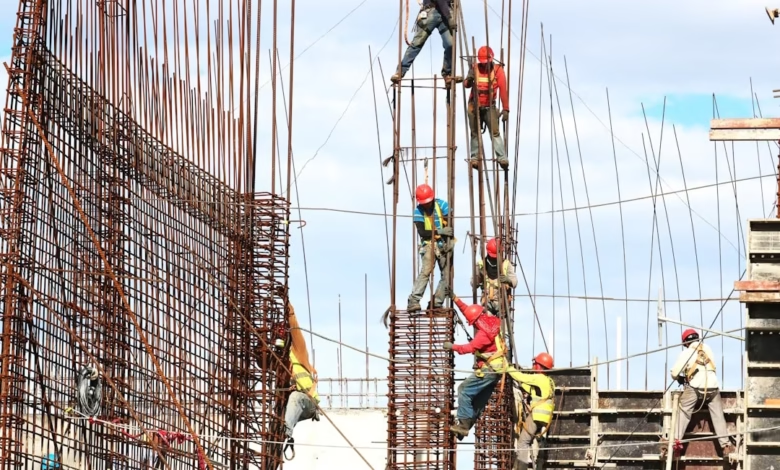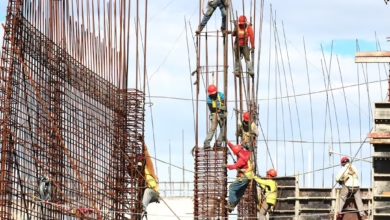Exploring Construction Metals: The Essential Role of Steel, Aluminum, and Sustainable Innovations in Modern Building

In the ever-evolving world of construction, the materials we choose play a pivotal role in shaping our built environment. Among these materials, metals stand out for their strength, versatility, and longevity. This article delves into the essential role of construction metals, focusing on steel, aluminum, and other industrial metals that form the backbone of modern building practices. As we explore the intricate landscape of metals, we will discuss the significance of ferrous and non-ferrous metals in construction, highlighting their applications and advantages.
Additionally, as the construction industry grapples with environmental challenges, sustainable metal production has emerged as a critical area of innovation. We will examine advancements in metal recycling and metallurgy, showcasing how eco-friendly practices are transforming the way we source and use metals in construction.
Finally, we will look towards the future, discussing emerging trends in metal alloys and their potential impact on not only the construction sector but also the aerospace and automotive industries. With a focus on the latest developments in metal fabrication, 3D printing metals, and the evolving landscape of metal commodities, this article aims to provide a comprehensive overview of construction metals and their significance in both current and future applications. Join us as we navigate the fascinating world of metals, from precious metals like gold and silver investing to the base metals that drive the construction industry forward.
- 1. Exploring Construction Metals: The Role of Steel, Aluminum, and Other Industrial Metals in Modern Building
- 2. Sustainable Metal Production: Innovations in Metal Recycling and Metallurgy for Eco-Friendly Construction
- 3. The Future of Construction Metals: Trends in Metal Alloys and Their Impact on the Aerospace and Automotive Industries
1. Exploring Construction Metals: The Role of Steel, Aluminum, and Other Industrial Metals in Modern Building
In the modern construction landscape, various metals play a critical role in building materials, influencing both structural integrity and design aesthetics. Steel and aluminum are the most commonly used construction metals due to their unique properties and versatility. Steel, a ferrous metal, is favored for its strength and durability, making it a staple in high-rise buildings and infrastructure projects. Its ability to withstand heavy loads and resist metal corrosion makes it ideal for various applications, from beams to reinforcements.
On the other hand, aluminum, a prominent non-ferrous metal, is celebrated for its lightweight nature and resistance to corrosion. This makes it a popular choice in construction, particularly in architectural elements like window frames, roofing, and facades. Additionally, aluminum's inherent recyclability supports sustainable metal production practices, aligning with the growing emphasis on environmentally responsible construction.
Other industrial metals, such as copper and zinc, also contribute significantly to building materials. Copper is widely used in electrical wiring and plumbing due to its excellent conductivity and resistance to corrosion. Zinc, often utilized as a protective coating for steel, enhances durability and prevents rusting, further extending the lifespan of construction metals.
The trend towards metal recycling is gaining momentum in the construction industry, with many companies seeking to utilize reclaimed materials to reduce waste and promote sustainable practices. This approach not only conserves resources but also supports the circular economy, where metals are reused and repurposed, minimizing the need for new metal mining and reducing environmental impact.
In addition to traditional construction metals, rare earth metals and metal alloys are increasingly being integrated into advanced building materials. These materials are crucial for developing cutting-edge technologies, including 3D printing metals that enable the fabrication of complex structures with precision and efficiency.
As we look toward the future, the demand for energy metals, such as lithium and platinum, is anticipated to rise, driven by innovations in battery technology and renewable energy systems. Similarly, aerospace metals and automotive metals are becoming more relevant as industries shift towards sustainable practices and lighter materials to improve fuel efficiency.
In summary, the exploration of construction metals, including steel, aluminum, and other industrial metals, showcases their indispensable role in modern building. Through advancements in metallurgy and a focus on sustainable metal production, the construction industry can continue to evolve, utilizing a diverse range of metals to create structures that are not only functional but also environmentally conscious.
2. Sustainable Metal Production: Innovations in Metal Recycling and Metallurgy for Eco-Friendly Construction
Sustainable metal production has become a pivotal focus in the construction industry, driven by the need for eco-friendly practices and the efficient use of resources. Innovations in metal recycling and metallurgy are paving the way for a greener future in building materials. The integration of recycled metals into construction not only conserves energy but also reduces the environmental impacts associated with metal mining and production.
Metal recycling plays a crucial role in sustainable practices, particularly for both ferrous and non-ferrous metals. Steel, aluminum, copper, and zinc are commonly recycled metals that significantly decrease the need for primary production. For instance, recycling aluminum can save up to 95% of the energy required to produce new aluminum from raw bauxite. This energy efficiency is essential as the construction sector increasingly turns towards sustainable metal production to meet regulatory and consumer demands.
Recent advancements in metallurgy have also contributed to eco-friendly construction. The development of metal alloys with enhanced properties allows for the use of less material without sacrificing strength or durability. This innovation is particularly important in construction, where the structural integrity of materials like steel and aluminum is paramount. Furthermore, the emergence of 3D printing metals enables the production of custom components with minimal waste, further advancing sustainability within the industry.
In addition to the traditional metals mentioned, the focus on battery metals such as lithium and rare earth metals is growing due to their increasing importance in renewable energy solutions. These materials are essential for energy storage systems and electric vehicles, which are integral to sustainable urban development. As the demand for green technologies rises, so too does the necessity for responsible sourcing and recycling of these precious and industrial metals.
The trends in metal production are shifting towards a circular economy where recycling and reuse take precedence over extraction. This not only helps in minimizing metal corrosion and extending the lifespan of construction metals but also aligns with global efforts to reduce waste and carbon footprints. By investing in sustainable metal production methods, the construction industry can significantly contribute to environmental conservation while meeting the growing demand for innovative building solutions.
Through these efforts, the construction sector can leverage the benefits of sustainable metal production, ensuring that metals like steel, aluminum, and copper remain viable for future generations. As we look forward, it is clear that embracing these advancements in metal recycling and metallurgy will be key to achieving eco-friendly construction goals.
3. The Future of Construction Metals: Trends in Metal Alloys and Their Impact on the Aerospace and Automotive Industries
The future of construction metals is poised for significant transformation, particularly in the realms of aerospace and automotive industries. As technology advances, the demand for lighter, stronger, and more adaptable metal alloys is increasing. This shift is driven by the need for enhanced performance and sustainability, which influences both metal fabrication and metallurgy practices.
One of the most notable trends is the development of advanced metal alloys that combine ferrous and non-ferrous metals, such as steel and aluminum, with rare earth metals and other base metals. These innovative alloys provide improved strength-to-weight ratios, making them ideal for aerospace applications where reducing weight can lead to increased fuel efficiency. For instance, aluminum-lithium alloys are gaining traction in aircraft manufacturing due to their lightweight properties and resistance to metal corrosion.
In the automotive sector, the rise of electric vehicles (EVs) is prompting a reevaluation of metal commodities used in production. Battery metals like lithium, cobalt, and nickel are becoming increasingly valuable as manufacturers seek sustainable solutions for energy storage. This trend is also driving metal mining practices toward more environmentally friendly methods, emphasizing sustainable metal production and metal recycling processes.
Moreover, 3D printing metals are revolutionizing how components are manufactured in both industries. This technology allows for the creation of complex geometries and custom parts from a variety of metals, including precious metals like platinum and palladium, which can be utilized in specialized applications. The ability to rapidly prototype using these advanced materials can significantly reduce waste and lead times in construction projects.
As the demand for sustainable practices intensifies, the aerospace and automotive industries are actively exploring innovative materials that reduce their carbon footprint. This includes not only the use of recycled metals but also the development of refractory metals that can withstand extreme temperatures and pressures, thus extending the lifespan of components.
In conclusion, the future of construction metals, particularly in aerospace and automotive sectors, is marked by a shift towards advanced metal alloys, sustainable practices, and cutting-edge technologies like 3D printing. As these trends evolve, they will undoubtedly shape the landscape of industrial metals and influence investment opportunities in gold, silver, and other precious metals, making it vital for stakeholders to stay informed about these developments.
In conclusion, the use of construction metals such as steel, aluminum, copper, and zinc plays a pivotal role in modern building practices. As we explored, the significance of industrial metals extends beyond mere structural support, impacting various industries including aerospace and automotive sectors. The ongoing innovations in sustainable metal production, particularly through metal recycling and advanced metallurgy, are crucial for reducing the environmental footprint of construction activities.
Furthermore, the future of construction metals looks promising with emerging trends in metal alloys and their applications across diverse fields. From 3D printing metals to the utilization of rare earth metals in high-tech construction, the landscape is evolving rapidly. As stakeholders in the construction industry embrace these advancements, they also pave the way for more eco-friendly practices, contributing to a sustainable future.
Investing in metals—be it base metals or precious metals like gold and silver—also presents opportunities for financial growth, underscoring the importance of understanding metal commodities in today’s market. As we move forward, staying informed about metal trends and innovations will be essential for anyone involved in construction, manufacturing, or investment. By prioritizing sustainable practices and leveraging the latest developments in metallurgy and metal fabrication, we can build a resilient and environmentally conscious future.





